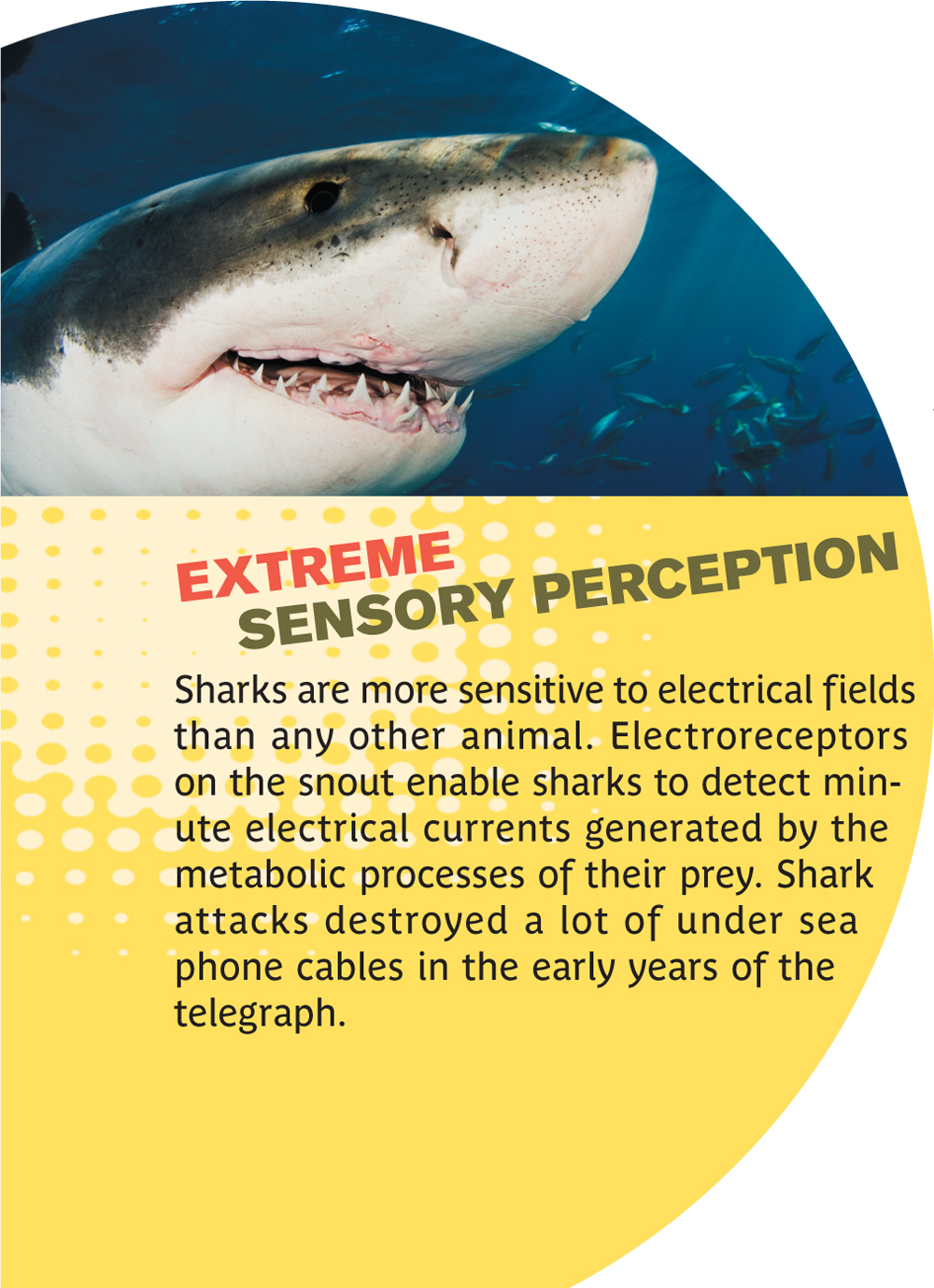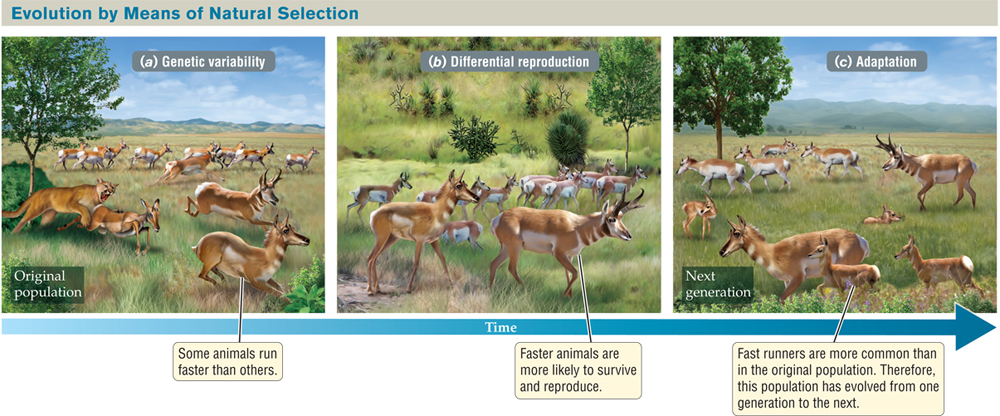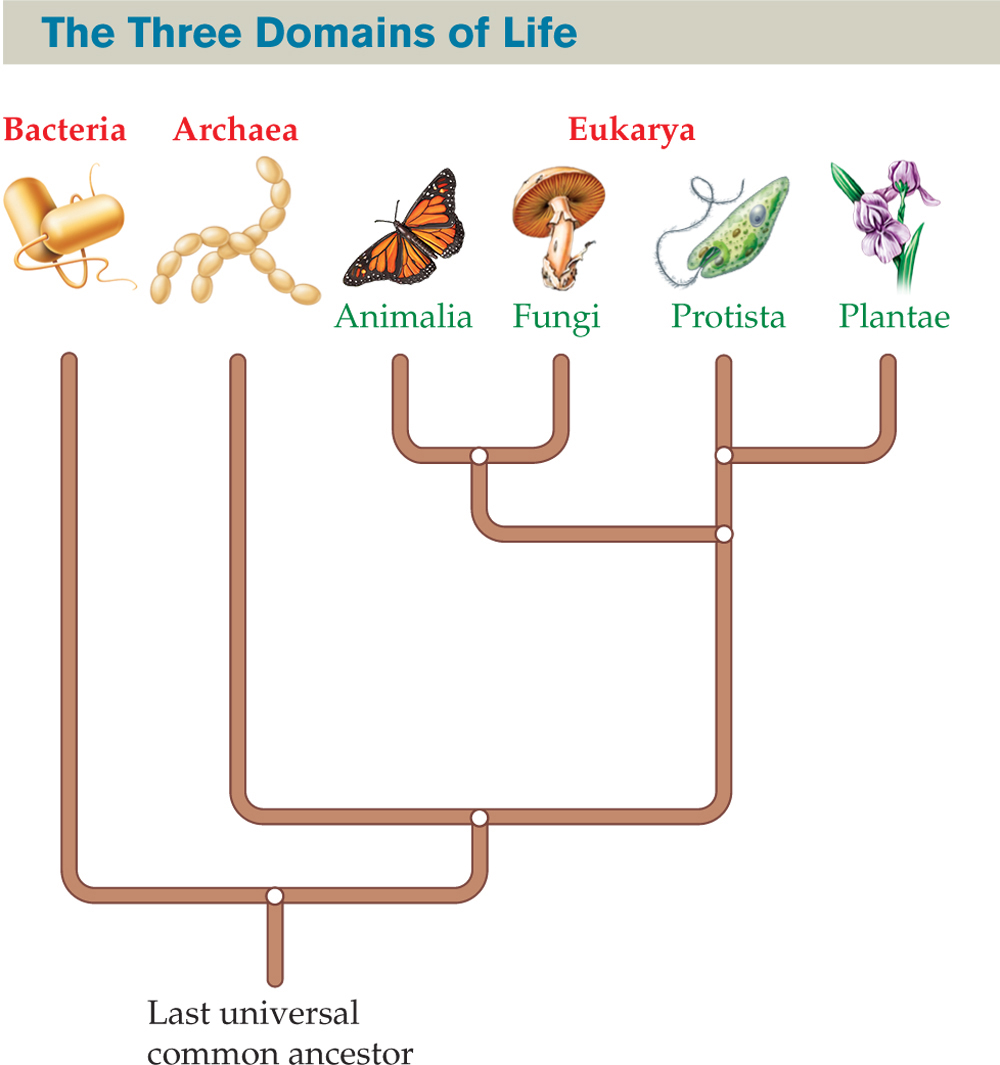■ Camouflage coloration ■ High running speed ■ Large eyes set high on the head for 320-degree field of vision ■ Very large lungs and heart for sustained running ■ Hollow hair for insulation against winter cold ■ Strong grinding teeth (molars) for breaking up tough plant food ■ Four-chambered stomach for digesting plant food with the help of bacteria ■ Long intestines for digesting and absorbing nutrient-poor plant material |
1.5 |
Biological Evolution and the Unity and Diversity of Life |
The fact of biological evolution, and the theories that explain the mechanisms by which it occurs, are central to our modern understanding of life. Evolution explains the unity of life: why all living organisms are like each other in certain key aspects (see Table 1.4). Evolution also explains the diversity of life: how life-forms, from arsenic bacteria to woolly mammoths, became different from each other.
As noted in the preceding section, biological evolution is a change in the overall genetic characteristics of a group of organisms over the generations, from parents to offspring. By “overall genetic characteristics,” we mean the sum total of all the inherited characteristics that we can observe in the different individuals that make up a group of organisms. Antler size, coat color, running speed, and maternal care are examples of genetic characteristics that are readily observed. If we see a change in the commonness, or frequency, of one or more of these characteristics from one generation to the next, we say that the group as a whole has evolved (FIGURE 1.17). Notice that it is groups of organisms that evolve, not an individual organism such as a certain white-tailed deer or a particular red oak tree.
FIGURE 1.17 Groups of Living Organisms Can Evolve
Natural selection, exerted through predators looking for a meal, favors the survival and reproduction of fast pronghorn over the slower animals in the population. As a result, the next generation of pronghorn contains many more fast runners. Over the generations, the pronghorn population has evolved to exhibit a greater average running speed than the ancestral population had.
Populations of a given species can evolve over the generations
We define a species as all individuals that can interbreed in their natural surroundings to produce fertile offspring. For example, all pronghorn belong to a single species, as do all monarch butterflies, and all sugar maple trees. All species known to science are given a two-part scientific name, such as Antilocapra americana for the pronghorn. A population is a group of individuals of a particular species that shares a common habitat—all the pronghorn in the high plains of western Wyoming, for example.
Evolution can be considered at many levels, from populations on up. Scientists might consider the evolution of all the pronghorn in western Wyoming, or all the pronghorn in North America. Pronghorn might also be considered in the context of a larger group, or family. Some 5–20 million years ago, the pronghorn family (Antilocapridae) consisted of many species, but A. americana is the sole surviving member of the family. The pronghorn family is placed in a larger grouping (order) that includes all animals with two even hooves (encompassing pronghorn, cattle, deer, and pigs). All two-hoofed animals are placed in the very large grouping (class) known as mammals, in which females produce milk to feed their young. All mammals are part of a yet larger group (phylum); phylum Chordata includes all animals with a backbone and also some less familiar relatives, such as sea squirts, that have developmental similarities. Chordates, along with all other animals, are placed in the kingdom Animalia.
Natural selection favors individuals with adaptive traits
Natural selection is an evolutionary mechanism that changes the overall genetic composition of a population from one generation to the next by favoring the survival and reproduction of individuals best suited to their environment. Which individuals are favored by natural selection? In a genetically diverse population, individuals that have certain advantageous characteristics, known as adaptive traits, are favored to survive and reproduce. For a prey species such as pronghorn, being fleet of foot is an adaptive trait. In a pronghorn population, speedy animals have greater reproductive success compared to slower animals (see Figure 1.17).
Natural selection adapts a population to its habitat
Natural selection causes the population as whole to become better adapted to its habitat. Adaptation refers to a good match between a population and its particular habitat. By favoring individuals with adaptive traits over those with maladaptive ones, natural selection drives the evolution of the whole population so that the adaptive traits become common in the population.
Pronghorn, which live on the dry plains and grasslands of western North America, are exquisitely adapted to their environment (TABLE 1.5). The original population of pronghorn must have been genetically varied with respect to the traits listed in the table. The presence of predators led to differential survival and reproduction. For example, swifter individuals were more likely to outrace their predators, whereas slower individuals were more likely to be eaten. More of the swift pronghorn survived to have offspring, and the trait consequently became more common in the descendant population (see Figure 1.17).
| TABLE 1.5 | Adaptive Traits in Pronghorn |
Darwin and Wallace explained how natural selection produces new species
British naturalists Charles Darwin (1809–1882) and Alfred Wallace (1823–1913) independently recognized that if two populations of a single species come to occupy very different habitats, they could become very different from one another. The reason is that over time, natural selection would drive the two populations along very different paths of adaptation. Eventually, these populations could become so different that they would lose the ability to interbreed and produce fertile offspring. The two newly evolved populations would then be recognized as different species, descended from a common ancestor.
This insight led Darwin to the conclusion that all present-day species are descended “with modification” from ancestral species: humans and all other mammals are descended from a common ancestor that lived many millions of years ago, all animals are descended from a common ancestor that lived even further back in time, and all animals and plants have a common ancestor yet further back in the history of life.
We can categorize all known species into three domains of life
To date, scientists have described about 1.7 million species, but this is only the tip of the diversity iceberg. A vast number of species remain to be discovered and cataloged. Even so, by comparing the similarities and dissimilarities among the known species—especially in the information encoded in their DNA—biologists have succeeded in placing most of the major life-forms into an elaborate “tree of life” (FIGURE 1.18). The main branches of this tree are the three biggest categories of life-forms, known as domains. The three domains of life are Bacteria, Archaea, and Eukarya.
FIGURE 1.18 The Tree of Life
This evolutionary tree depicts the origin and diversification of the three domains of life (in red). The four main kingdoms of the domain Eukarya are shown in green. The evolutionary relationships of the Protista are not well understood.

Bacteria and Archaea (ahr-kee-uh) are composed of single-celled organisms, the great majority of which are microscopic. DNA evidence tells us that Bacteria and Archaea are substantially different because they diverged from each other billions of years ago and have been evolving separately ever since. But because they are superficially similar, bacteria and archaeans have traditionally been lumped together as prokaryotes, a label of convenience.
Eukarya (yoo-kayr-ee-uh), the third domain of life, includes both single-celled and multicellular forms. This domain is divided into four kingdoms: Protista (algae, amoebas, and their relatives); Plantae (all the plants); Fungi (from yeasts to mushrooms); and Animalia, including animals with backbones (vertebrates) and those without (invertebrates).
Concept Check
1. Explain what is wrong with this statement: Over time, a male white-tailed deer evolves larger antlers.
An individual deer does not evolve. A population of deer, however, may evolve larger average antler size.
2. Which domain of life do humans belong to?
Eukarya.



